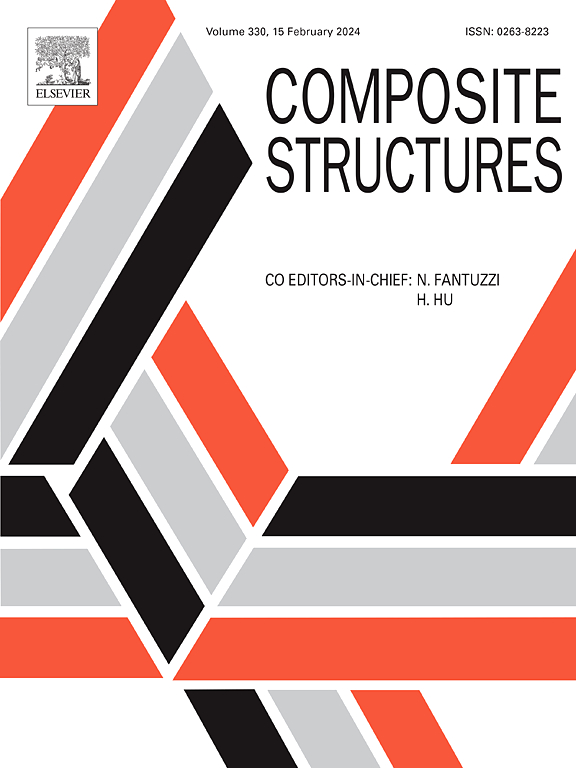Inverse design of NiTi alloy-based chiral metamaterials with multi-level rotational capabilities for reusable high-performance impact absorption
IF 6.3
2区 材料科学
Q1 MATERIALS SCIENCE, COMPOSITES
引用次数: 0
Abstract
High-performance impact-absorbing structures that combine exceptional energy absorption capabilities with high reusability represent a significant advancement in protective engineering. In this work, we present the development of three-dimensional (3D) chiral metamaterials and a sophisticated inverse design methodology specifically engineered to achieve tailored impact-absorbing properties. By harnessing the multi-level rotational mechanisms—encompassing localized and global beam rotations, as well as the overall structural rotation—during compression, coupled with the shape memory effect of nickel-titanium (NiTi) alloy, the designed structures demonstrate outstanding reusability in energy absorption. Utilizing the AI-driven approach that integrates machine learning with genetic algorithms, we successfully engineered six distinct structures with plateau stresses ranging from 0.025 MPa to 0.7 MPa. Uniaxial compression tests revealed excellent alignment with finite element analysis (FEA) predictions, exhibiting an average deviation of only 8.75 % from the target stress–strain profiles, thereby validating the robustness and precision of our inverse design methodology. Notably, the structure with a plateau stress of 0.05 MPa achieved an exceptional shape recovery ratio of 97.9 % following 80 % effective compression, underscoring its superior reusability. These findings underscore the transformative potential of 3D chiral metamaterials with multi-level rotational capabilities and their inverse design strategy in advancing the development of reusable, high-performance impact-absorbing structures.
具有可重复使用高性能冲击吸收的多层次旋转能力的NiTi基手性超材料的逆向设计
高性能冲击吸收结构结合了卓越的能量吸收能力和高可重复使用性,代表了防护工程的重大进步。在这项工作中,我们介绍了三维(3D)手性超材料的发展和一种复杂的逆设计方法,专门用于实现定制的冲击吸收性能。通过利用多层旋转机制——包括局部和全局梁旋转,以及整体结构旋转——在压缩过程中,再加上镍钛(NiTi)合金的形状记忆效应,设计的结构在能量吸收方面表现出出色的可重用性。利用人工智能驱动的方法,将机器学习与遗传算法相结合,我们成功地设计了六个不同的结构,平台应力范围从0.025 MPa到0.7 MPa。单轴压缩试验显示,与有限元分析(FEA)预测结果非常吻合,与目标应力-应变曲线的平均偏差仅为8.75%,从而验证了我们的反设计方法的稳健性和精度。值得注意的是,在平台应力为0.05 MPa的情况下,在80%的有效压缩下,结构的形状恢复率达到了97.9%,突出了其优越的可重复使用性。这些发现强调了具有多层次旋转能力的3D手性超材料的变革潜力,以及它们在推进可重复使用、高性能吸冲击结构开发方面的逆向设计策略。
本文章由计算机程序翻译,如有差异,请以英文原文为准。
求助全文
约1分钟内获得全文
求助全文
来源期刊

Composite Structures
工程技术-材料科学:复合
CiteScore
12.00
自引率
12.70%
发文量
1246
审稿时长
78 days
期刊介绍:
The past few decades have seen outstanding advances in the use of composite materials in structural applications. There can be little doubt that, within engineering circles, composites have revolutionised traditional design concepts and made possible an unparalleled range of new and exciting possibilities as viable materials for construction. Composite Structures, an International Journal, disseminates knowledge between users, manufacturers, designers and researchers involved in structures or structural components manufactured using composite materials.
The journal publishes papers which contribute to knowledge in the use of composite materials in engineering structures. Papers deal with design, research and development studies, experimental investigations, theoretical analysis and fabrication techniques relevant to the application of composites in load-bearing components for assemblies, ranging from individual components such as plates and shells to complete composite structures.
 求助内容:
求助内容: 应助结果提醒方式:
应助结果提醒方式:


